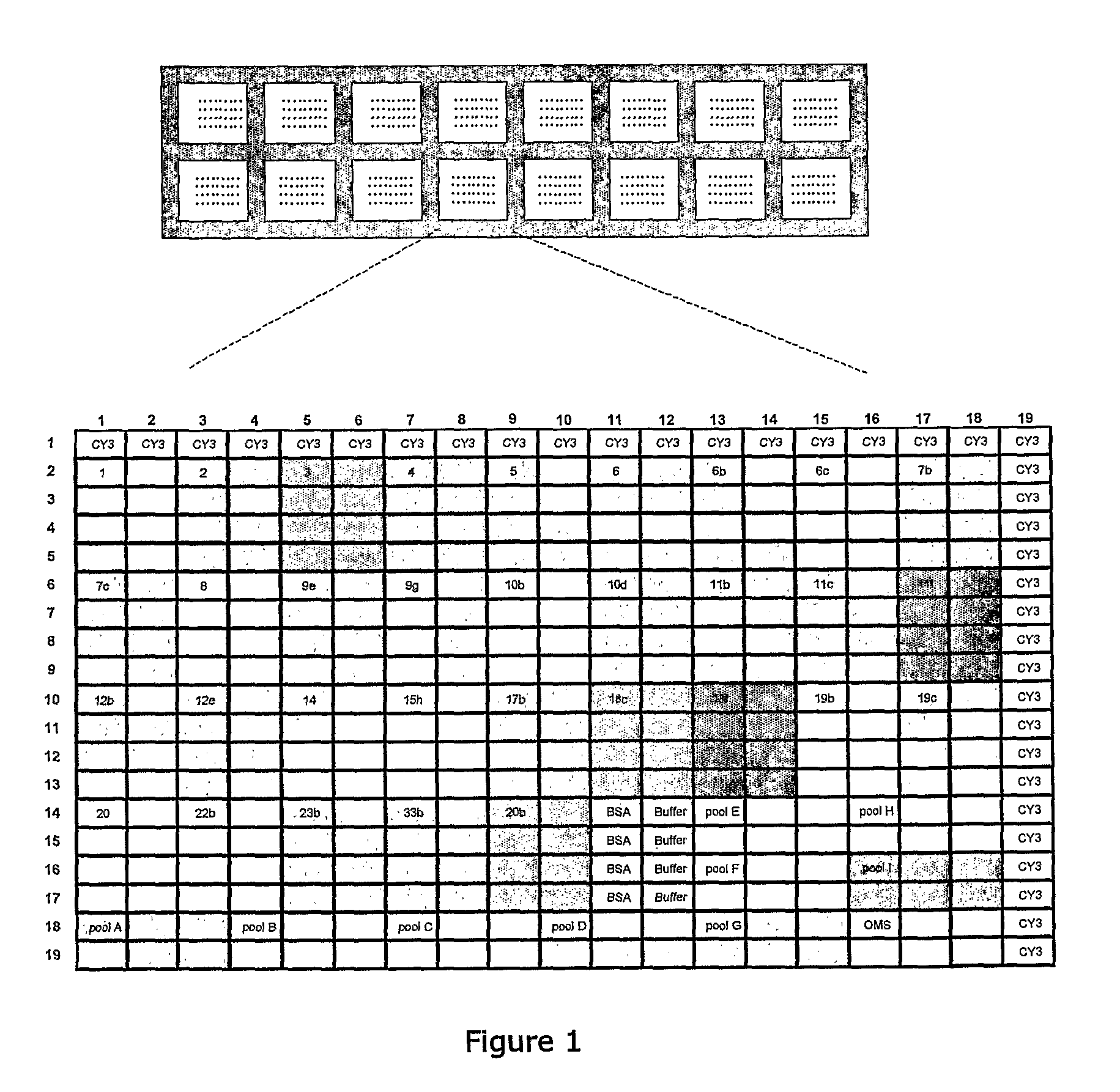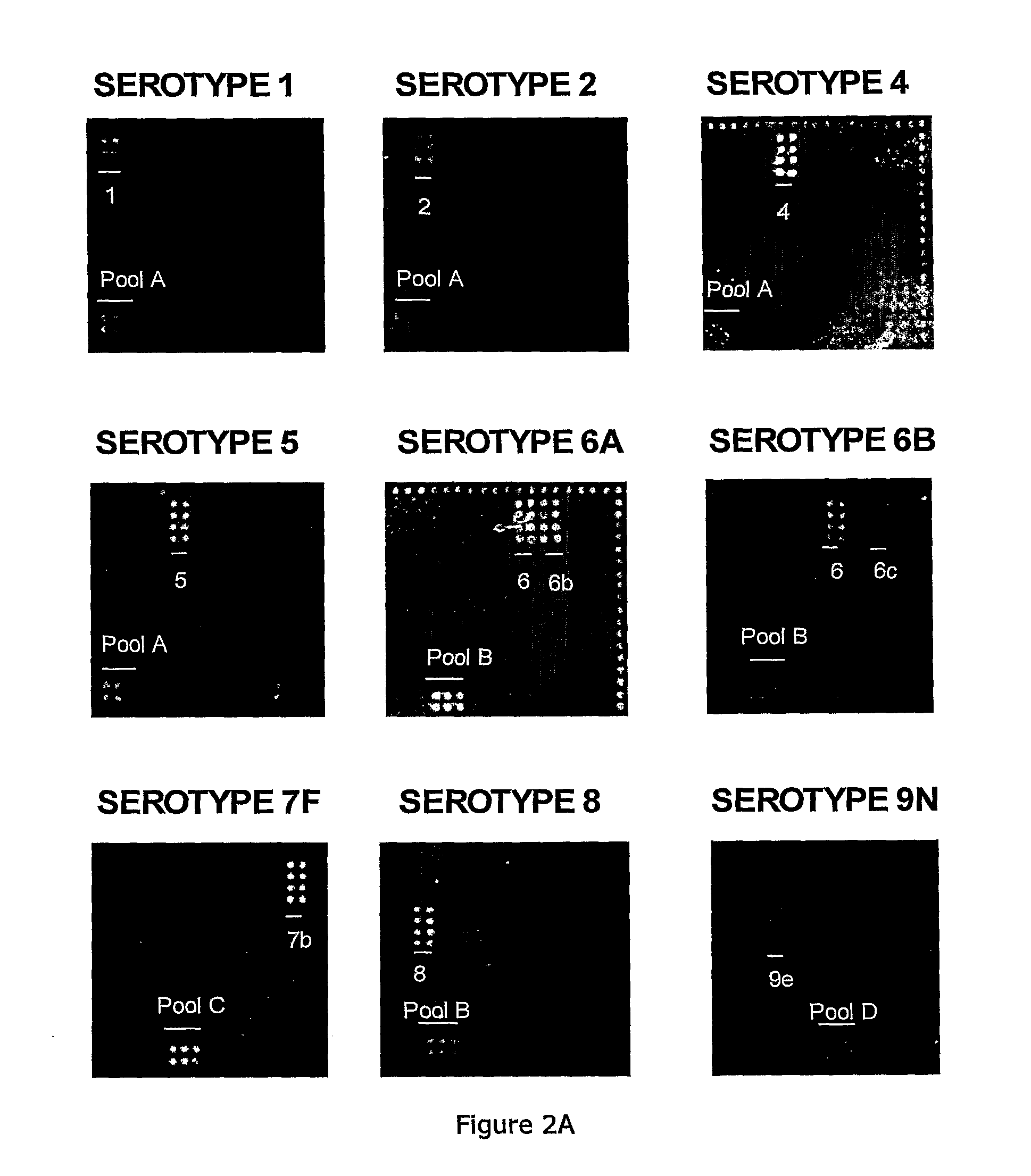Methods and products for identifying strains of bacteria
a technology for identifying bacteria and products, applied in the field of methods and products for identifying bacteria strains, can solve problems such as limited serotype repertoir
- Summary
- Abstract
- Description
- Claims
- Application Information
AI Technical Summary
Benefits of technology
Problems solved by technology
Method used
Image
Examples
example 1
Growth of S. pneumoniae Bacteria
[0101]Streptococcus pneumoniae strains were isolated from clinical samples (hemoculture samples) using enriched growth media for this bacteria as indicated in standard clinical protocols. After testing positive in the optoquin-sensitivity test (Bowen, 1957), the isolates were picked and cultured on plates containing blood agar, grown overnight at 37° C. with 5% CO2. After a minimum of 16 h, one aliquot from each plate was pelleted by centrifugation, washed with TBS buffer and resuspended in TBS buffer for serotyping using microarray chip (as described further herein). The remainder of the bacterial sample was stored at −80° C. Alternatively, liquid cultures were also performed from the isolates by inoculating an aliquot of each strain into a tube containing 3 mL of Todd-Hewitt growth medium (CM0189, Oxoid, Hampshire, UK) enriched with 0.5% Yeast extract (LP0021, Oxoid).
Microarray Production
[0102]Factor, type, group and pool antisera and omniserum for ...
example 2
Serotyping of Strain 3 Using a Sandwich Method
[0114]Labelling of group serum 3 with biotin and streptavidin-phycoerythrin: Biotin-XX (Invitrogen) was used to label the IgGs contained in the type serum 3. Biotin-XX was dissolved in DMF (Fluke, Sigma-Aldrich, St. Louis, Mo., USA) at 15 mM, aliquots were made and stored at −80° C. until use. Protein content in type serum 3 was quantified using Bradford method. The labelling was performed as follows: 45 μL of antiserum was mixed with 5 μL of carbonate buffer 100 mM, pH 9.4, and the corresponding amount of biotin-XX was added to the mixture. The mixture was incubated for 30 min at room temperature. Meanwhile a column for gel filtration was prepared. Bio-Gel P6 Fine slurry (Bio-Rad) was hydrated in PBS (Sigma-Aldrich) according to the manufacturer's instructions, homogenized and a mini-spin column was prepared (Nanosep MF 0.2 um, Pall Corp., NY, USA). The mini-spin column was centrifuged for 15 s and PBS was removed. The labelling mixture...
example 3
Growth of S. pneumoniae Bacteria
[0118]Streptococcus pneumoniae strains were isolated from clinical samples (hemoculture samples) using enriched growth media for this bacteria as indicated in standard clinical protocols. After testing positive in the optoquin-sensitivity test (Bowen, 1957), the isolates were picked and cultured on plates containing blood agar, grown overnight at 37° C. with 5% CO2. After a minimum of 16 h, bacteria were collected in a single pass using an inoculating loop of 1 μL and resuspended in 200 μL of TBST-T-BSA 5% buffer (Labelling Buffer) for serotyping using microarray chip (as described further herein). The remainder of the bacterial sample was stored at −80° C. Alternatively, liquid cultures were also performed from the isolates by inoculating an aliquot of each strain into a tube containing 3 mL of Todd-Hewitt growth medium (CM0189, Oxoid, Hampshire, UK) enriched with 0.5% Yeast extract (LP0021, Oxoid). As labelling reagent SYTO 25 at 20 μM in DMSO was u...
PUM
| Property | Measurement | Unit |
|---|---|---|
| pH | aaaaa | aaaaa |
| pH | aaaaa | aaaaa |
| diameter | aaaaa | aaaaa |
Abstract
Description
Claims
Application Information
 Login to View More
Login to View More - R&D
- Intellectual Property
- Life Sciences
- Materials
- Tech Scout
- Unparalleled Data Quality
- Higher Quality Content
- 60% Fewer Hallucinations
Browse by: Latest US Patents, China's latest patents, Technical Efficacy Thesaurus, Application Domain, Technology Topic, Popular Technical Reports.
© 2025 PatSnap. All rights reserved.Legal|Privacy policy|Modern Slavery Act Transparency Statement|Sitemap|About US| Contact US: help@patsnap.com



